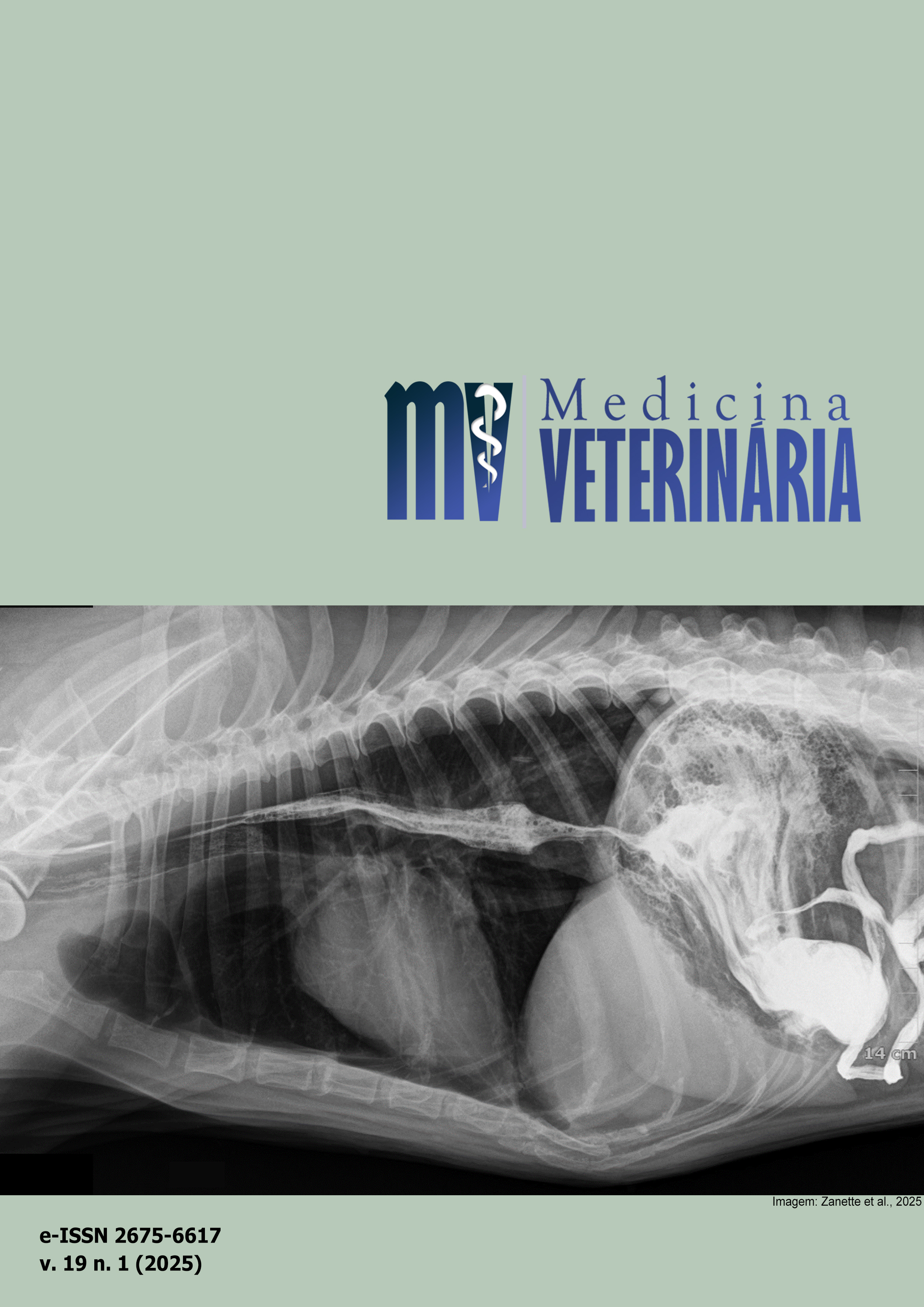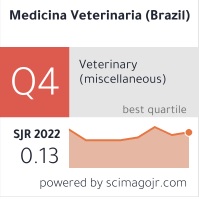Detecção de aumento atrial esquerdo em cães usando deep learning em radiografias torácicas
DOI:
https://doi.org/10.26605/medvet-v19n1-6639Palavras-chave:
diagnóstico auxiliado por computador, cardiopatia, classificador de imagensResumo
Objetivou-se desenvolver uma ferramenta para auxiliar o médico veterinário no diagnóstico do aumento do átrio esquerdo em radiografias de tórax em cães. O modelo contém um total de 652 imagens, todas usadas no treino e no teste, divididas em duas categorias: “positiva” e “negativa”. Foram usados três algoritmos obtendo os seguintes resultados: a acurácia da rede neural foi de 89.7%, sensibilidade de 90%, especificidade de 89.5% e área sob a curva (AUC), 95.8%. A acurácia da regressão logística foi de 88.2%, sensibilidade de 88.7%, especificidade de 87.3% e AUC 94.4%. A acurácia da árvore foi de 69.6%, sensibilidade de 68.0%, especificidade de 71.0% e AUC 69.6%. O modelo classificador com diferentes algoritmos poderá ajudar os radiologistas a melhorar na análise de imagens médicas com redução de erros, iniciando a leitura dupla seletiva.Downloads
Referências
Abbott, J.A. Cardiomiopatia dilatada canina. In:_____. Segredos em cardiologia de pequenos animais. Porto Alegre: Artmed, 2006. p.304-314.
Alpaydin, E. Multilayer Perceptrons. In: Introduction to machine learning, 3rd ed. London: MIT Press, 2014. p.267-316.
Bahr, R.O Coração e os Vasos Pulmonares. In: Thrall, D.E. (Ed.). Diagnóstico de radiologia veterinária, 6a ed. Rio de Janeiro: Elsevier, 2015. p1220-1261.
Burti, S. et al. Use of deep learning to detect cardiomegaly on thoracic radiographs in dogs. The Veterinary Journal, 262: 1-7, 2020.
Derkatch, S. et al. Identification of vertebral fractures by convolutional neural networks to predict nonvertebral and hip fractures: a registry-based cohort study of dual x-ray absorptiometry. Radiology, 293(2): 1-7, 2019.
Du, D.Z.; Ko, K.I. Models of computation and complexity classes. In:_____. Theory of computational complexity. 2nd ed. Hoboken: John Wiley & Sons, 2011. p.3-44.
Godec, P. et al. Democratized image analytics by visual programming through integration of deep models and small-scale machine learning. Nature Communications, 10 (1): 1-7, 2019.
Gunderman, R.B.; Patel, P. Perception’s crucial role in radiology education. Academic Radiology, 26(1): 141–143. 2019.
Kealy, J.K.; McAllister, H. O tórax. In:_____. Radiologia e ultrassonografia do cão e do gato. 3a ed. Barueri: Manole, 2005. p.149-252.
Lamb, C.R. Veterinary diagnostic imaging: Probability, accuracy and impact. The Veterinary Journal, 215: 55-63, 2016.
Lamb, C.R.; Nelson, J.R. Diagnostic accuracy of tests based on radiologic measurements of dogs and cats: a systematic review. Veterinary Radiology & Ultrasound, 56(3): 231-244, 2015.
Li, S. et al. Pilot study: Application of artificial intelligence for detecting left atrial enlargement on canine thoracic radiographs. Veterinary Radiology & Ultrasound, 61(6): 611-618, 2020.
Liang, C.H. et al. Identifying pulmonary nodules or masses on chest radiography using deep learning: external validation and strategies to improve clinical practice. Clinical Radiology, 75(1): 38-45, 2019.
Malcolm, E.L. et al. Diagnostic value of vertebral left atrial size as determined from thoracic radiographs for assessment of left atrial size in dogs with myxomatous mitral valve disease. Journal of the American Veterinary Medical Association, 253(8): 1038-1045, 2018.
Rajpurkar, P. et al. Deep learning for chest radiograph diagnosis: A retrospective comparison of the CheXNeXt algorithm to practicing radiologists. PLoS Med, 15(11): 1-17, 2018.
Shorten, C.; Khoshgoftaar, T.M. A survey on Image Data Augmentation for Deep Learning. Journal of Big Data, 60(1): 1-48, 2019.
Thian, Y.L. et al. Convolutional Neural Networks for Automated Fracture Detection and Localization on Wrist Radiographs. Radiology: Artificial Intelligence, 1(1): 1-8, 2019.
Thrall, D.E. Introdução à Interpretação Radiográfica. In:_____. Diagnóstico de radiologia veterinária. 6a ed. Rio de Janeiro: Elsevier, 2015. p.175-209.
Ucar, F.; Korkmaz, D. COVIDiagnosis-Net: Deep Bayes-SqueezeNet based diagnosis of the coronavirus disease 2019 (COVID-19) from X-ray images. Medical Hypotheses, 140: 1-12, 2020.
Van Vleet, J.F.; Ferrans, V.J. Patologia do sistema cardiovascular. In: Carlton, W.W., McGavian, M.D., (Ed.). Patologia veterinária especial. 2a ed. Rio Grande do Sul: Artmed, 1998. p.194-227.
Webb, S. Technology feature deep learning for biology. Nature, 554(7693): 555-557, 2018.
White, S.C. Cysts of the jaws. In: White, S.C.; Pharoah, M.J. Oral Radiology: principles and interpretation. 5th ed. St. Louis: Mosby, 2004. p.355-377.
Downloads
Publicado
Como Citar
Edição
Seção
Licença
Copyright (c) 2025 Lucas Auto Lopes, Anaemilia das Neves Diniz, Helio Silva Neto

Este trabalho está licenciado sob uma licença Creative Commons Attribution-NonCommercial-ShareAlike 4.0 International License.
- A Revista de Medicina Veterinária permite que o autor retenha os direitos de publicação sem restrições, utilizando para tal a licença Creative Commons CC BY-NC-SA 4.0.
- De acordo com os termos seguintes:
- Atribuição — Você deve dar o crédito apropriado, prover um link para a licença e indicar se mudanças foram feitas. Você deve fazê-lo em qualquer circunstância razoável, mas de nenhuma maneira que sugira que o licenciante apoia você ou o seu uso.
- NãoComercial — Você não pode usar o material para fins comerciais.
- CompartilhaIgual — Se você remixar, transformar, ou criar a partir do material, tem de distribuir as suas contribuições sob a mesma licença que o original.
- Sem restrições adicionais — Você não pode aplicar termos jurídicos ou medidas de caráter tecnológico que restrinjam legalmente outros de fazerem algo que a licença permita.










